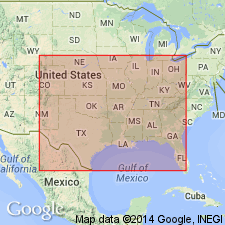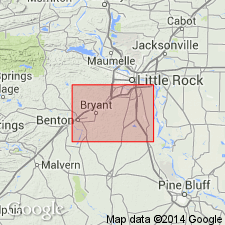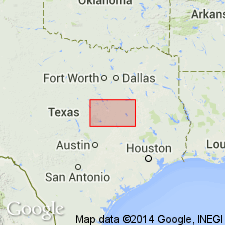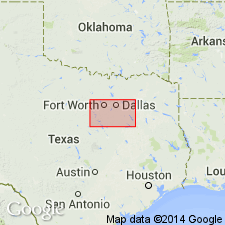
- Usage in publication:
-
- Tehuacana limestone
- Modifications:
-
- Original reference
- AAPG geologic province:
-
- East Texas basin
Harris, G.D., 1896, The Midway stage: Bulletins of American Paleontology, v. 1, no. 4, 157 p.
Summary:
Pg. 129, 155. Tehuacana limestone. In vicinity of Tehuacana, Limestone County, eastern Texas, the limestone beds of the Midway aggregate at least 40 feet. They are overlain by yellowish and bluish, slightly argillaceous sandy layers, which so far as observed are unfossiliferous. West of the College, say 0.5 mile, yellowish calcareous sands occur 45 feet or more below base of the limestone (p. 129). [In correlation table on p. 155 Harris placed Tehuacana limestone in middle Midway, and showed it as overlain by upper Midway sandstone to south of Tehuacana and as underlain by lower Midway boulder clay to north of Tehuacana, and he called the upper Midway the Wills Point clays and sand, which is a restriction of Wills Point as used by others.]
Source: US geologic names lexicon (USGS Bull. 896, p. 2123-2124).
- Usage in publication:
-
- Tehuacana limestone
- Modifications:
-
- Areal extent
- AAPG geologic province:
-
- East Texas basin
Plummer, F.B., and Plummer, H.J., 1928, Midway correlations on the basis of Foraminifera [abs.]: Pan-American Geologist, v. 49, p. 297., See also GSA Bull., v. 39, no. 1, p. 278, March, 30, 1928
Summary:
Divided Midway into an upper zone of sandy clays and silts containing large concretionary masses, a middle zone of dark-gray clays, and a basal zone of yellowish or buff-gray clays and glauconitic sands, and stated "that the lowest and middle divisions are in some places separated by a limestone lentil known as the Tehuacana limestone, and in other places by a layer of glauconitic sand." [Age is early Eocene.]
Source: US geologic names lexicon (USGS Bull. 896, p. 2123-2124).

- Usage in publication:
-
- Tehuacana limestone lentil*
- Modifications:
-
- Principal reference
- Revised
- AAPG geologic province:
-
- East Texas basin
Summary:
Pg. 496, 532, 535, 536, 539, 541, 542, 544, 545, 553. Tehuacana limestone lentil of Pisgah member of Kincaid formation of Midway group. Top part of Pisgah member. Proposed by Harris (1896) for the Midway limestone at Tehuacana. Consists of 4 to 50 feet of coquina, oolite, compact indurated shell marl and limestone. Extends through Limestone, Navarro, and Kaufman Counties, eastern Texas. Underlies Wills Point formation [restricted]. [Age is early Eocene.]
Type locality: abandoned quarry at Tehuacana, Limestone Co., eastern TX.
Source: US geologic names lexicon (USGS Bull. 896, p. 2123-2124).
- Usage in publication:
-
- Tehuacana member
- Modifications:
-
- Revised
- AAPG geologic province:
-
- East Texas basin
Gardner, J.A., 1935, The Midway group of Texas, including a chapter on the coral fauna by T.W. Vaughan and W.P. Popenoe: University of Texas Bulletin, no. 3301, 403 p., Prepared in cooperation with the U.S. Geological Survey; published May, 1935
Summary:
Pg. 22-26. Tehuacana member of Kincaid formation of Midway group. Excluded these beds from Pisgah member and treated them as a distinct member, called Tehuacana member of Kincaid formation, which she described as consisting of calcareous cement, the heavy glauconitic, highly fossiliferous, loosely indurated sands with or without phosphatic nodules, and all other equivalent deposits between top of Pisgah member (restricted) and base of Wills Point formation. The name Tehuacana "limestone" commonly applied to this unit is largely a misnomer, although it does contain intercalated sandy limestone lenses. Lower part of Tehuacana is typically exposed along west face of scarp on which town of Tehuacana stands. The higher horizons best represented in the quarry 0.5 mi east of the town. About 72 feet of section are included in the Tehuacana outcrops. About 20 feet above base is oyster bed, and 10 feet higher is another oyster bed. Maximum thickness of outcrop is less than 100 feet, but indicated thickness in well logs approximates 200 feet. [Age is early Eocene.]
Source: US geologic names lexicon (USGS Bull. 896, p. 2123-2124).

- Usage in publication:
-
- Tehuacana member*
- Modifications:
-
- Areal extent
- AAPG geologic province:
-
- East Texas basin
Summary:
Pg. 13-14. Tehuacana member of Kincaid formation of Midway group. Uppermost member of Kincaid formation in Texas. Overlies Pisgah member. Consists of grayish-white fossiliferous limestone and greenish-gray calcareous sandstone. Beds laterally equivalent of the Tehuacana extend northeastward across the state in a narrow discontinuous belt from the Texas border to Little Rock and in more scattered outcrops to the southeast corner of Independence County. [Age is Paleocene.]
Source: Publication; US geologic names lexicon (USGS Bull. 1200, p. 3840).
- Usage in publication:
-
- Tehuacana member
- Modifications:
-
- Biostratigraphic dating
- AAPG geologic province:
-
- East Texas basin
Kellough, G.R., 1959, Biostratigraphic and paleoecologic study of Midway Foraminifera along Tehuacana Creek, Limestone County, Texas: Gulf Coast Association of Geological Societies Transactions, v. 9, p. 147-160.
Summary:
Pg. 153, 159-160. Tehuacana member of Kincaid formation of Midway group. In Tehuacana Creek section, Limestone County, northeastern Texas, Tehuacana member includes 35 feet of shaly sands and sandy limestones containing minor amounts of fine-grained glauconite. Is top member of Kincaid formation. Overlies Pisgah member of Kincaid formation; underlies Mexia member of Wills Point formation. [Foraminifera listed.] The Tehuacana lies in [locally defined] DISCORBIS NEWMANAE zonule, [in lower part of] GLOBIGERINA COMPRESSA-DAUBJERGENSIS zone of Loeblich and Tappan (1957, p. 173-177). Age is early Paleocene (Danian; Midwayan Provincial Age).
Source: Publication; US geologic names lexicon (USGS Bull. 1200, p. 3840).

- Usage in publication:
-
- Tehuacana Member
- Modifications:
-
- Mapped 1:250k
- Dominant lithology:
-
- Limestone
- Marl
- AAPG geologic province:
-
- East Texas basin
Summary:
Tehuacana Member of Kincaid Formation of Midway Group. Limestone, glauconitic, hard, indurated, grayish white, interbedded with gray marl, forms crest of prominent northwest-facing cuesta. Thickness up to 30 feet, absent south of Brazos River. Lies above Pisgah Member of Kincaid and below Wills Point Formation of Midway Group. Age is Eocene.
[Mapped in Falls, Limestone, and Navarro Cos., eastern TX.]
Source: Publication.

- Usage in publication:
-
- Tehuacana Member
- Modifications:
-
- Mapped 1:250k
- Dominant lithology:
-
- Limestone
- Marl
- AAPG geologic province:
-
- East Texas basin
Summary:
Tehuacana Member of Kincaid Formation of Midway Group. Limestone, silty, slightly glauconitic, hard, white to light gray, interbedded with light gray marl. Thickness up to 30 feet, outcrop discontinuous, absent south of Trinity River. Lies above Pisgah Member of Kincaid and below Wills Point Formation of Midway Group. Age is Paleocene; [age changed from Eocene, 1972 ed. of map].
[Mapped in Kaufman and Van Zandt Cos., eastern TX.]
Source: Publication; supplemental information from GNU records (USGS DDS-6; Denver GNULEX).
For more information, please contact Nancy Stamm, Geologic Names Committee Secretary.
Asterisk (*) indicates published by U.S. Geological Survey authors.
"No current usage" (†) implies that a name has been abandoned or has fallen into disuse. Former usage and, if known, replacement name given in parentheses ( ).
Slash (/) indicates name conflicts with nomenclatural guidelines (CSN, 1933; ACSN, 1961, 1970; NACSN, 1983, 2005, 2021). May be explained within brackets ([ ]).

